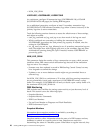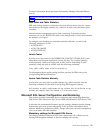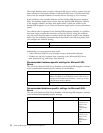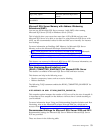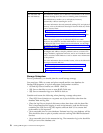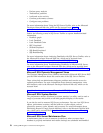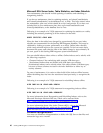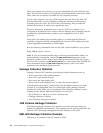
Feature Description
Hot Add CPU and
Hot Add Memory
Hot Add CPU enables you to add CPUs dynamically to the servers
without shutting down the server or limiting client connections.
Hot Add Memory enables you to add physical memory
dynamically without restarting the server.
For more information about dynamically adding CPU and physical
memory, refer to the Microsoft Developer Network Web site, which
can be accessed from:
v http://msdn.microsoft.com/en-us/library/bb964703.aspx (Hot
Add CPU)
v http://msdn.microsoft.com/en-us/library/ms175490.aspx (Hot
Add Memory)
Note: The above pages are for Microsoft SQL Server 2008.
However, Hot Add CPU and Hot Add Memory are also supported
in Microsoft SQL Server 2012. For more information, see the High
Availability section at https://msdn.microsoft.com/en-us/library/
bb630282%28v=sql.110%29.aspx.
Extended Events The extended events infrastructure enables administrators to
investigate and address complex problems such as excessive CPU
usage, deadlocks, application timeouts, and so on. Extended events
can be correlated with Windows events to obtain more information
of the problem.
For more information about extended events, refer to the Microsoft
Developer Network Web site:
v http://msdn.microsoft.com/en-us/library/bb630354.aspx
(Microsoft SQL Server 2008)
v https://msdn.microsoft.com/en-us/library/bb630282
%28v=sql.110%29.aspx (Microsoft SQL Server 2012)
Storage Subsystem
Prior to production, you should plan the overall storage strategy.
You must have DDLs to create and place tempdb and the user database for
Sterling B2B Integrator. A typical subsystem configuration would be:
v OS and SQL Server binaries on a RAID 1 disk set
v SQL Server data files on one or more RAID 5 disk sets
v SQL Server transaction logs on a RAID 10 disk set
Consider and ensure the following when planning a storage subsystem:
v Place SQL Server binaries on a separate set of physical disks other than the
database data and log files.
v Place the log files on physical disk arrays other than those with the data files.
This is important because logging is more write-intensive, and the disk arrays
containing the SQL Server log files require sufficient disk I/O to ensure that
performance is not impacted.
v Set a reasonable size for your database. Estimate how big your database will be.
This should be done as part of presales exercise working with IBM Professional
Services.
v Set a reasonable size for the transaction log. The transaction log's size should be
20–25 per cent of the database size.
56 Sterling B2B Integrator: Performance Management



